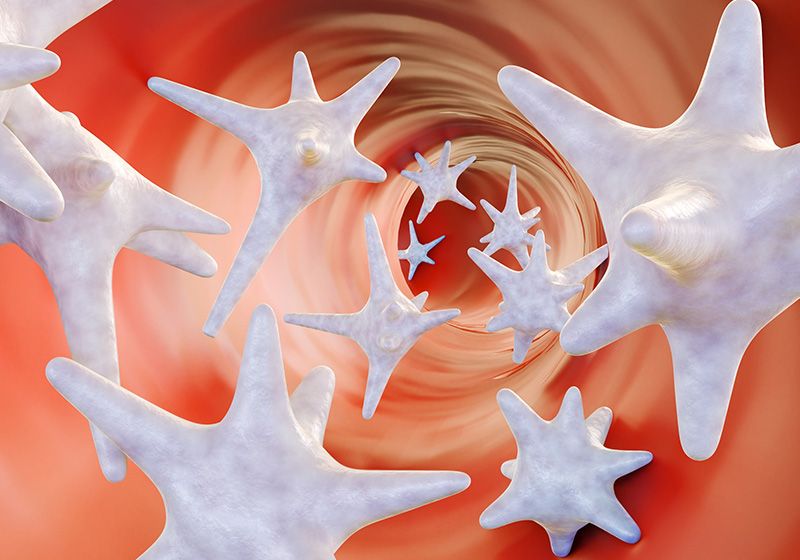Platelets are clot-forming cell fragments that circulate through the blood. They also store serotonin derived from the gut.
iStock, Love Employee
Serotonin is famous for its role as a mood-regulating neurotransmitter—several of the most commonly prescribed antidepressants are designed to boost levels of this molecule in the brain.1 However, over 90 percent of the body’s serotonin is produced in the gut, where it acts as a hormone and helps control digestion.2 Consequently, scientists think serotonin could play a key role in gut-brain communication with potential implications for cognition and mental health.3
However, it’s not clear what would drive serotonin from the gut to the brain. And once it got there, it would need help to cross the blood-brain barrier.4 Cristina Limatola, a neuroscientist at Sapienza University of Rome, wanted to understand how the molecule might make the trip. Now, in a study published in Cell Reports, Limatola and a team of researchers have identified the likely transporters: platelets.5
Platelets are clot-forming cell fragments that circulate through the blood. In retrospect, they make perfect sense as the body’s serotonin truckers because they absorb the gut-derived hormone, store it in granules, and then release it as part of their response to injury.6 However, Limatola said that her team didn’t start thinking about platelets until relatively late in their investigation.
Initially, they were interested in the interaction between the brain and natural killer (NK) cells, a type of white blood cell that eliminates threats like cancers and viruses. The team had previously shown that these immune cells could make their way into the brain and release interferons and neurotransmitters, which then directly affect neural circuits that regulate anxiety and memory.7 In that study, mice without NK cells spent more time boldly roaming their environment, and they had more trouble remembering objects they had previously encountered.
In the current study, the scientists thought NK cells might also have a direct impact on the brain chemicals that modulate the neural circuits involved in fear conditioning. Associations between startling stimuli and unpleasant events are formed in the hippocampus, and that process is regulated by serotonin.
Limatola’s team found that mice with depleted NK cells were more likely to freeze in response to a loud sound associated with an electric shock and that those mice had lower levels of serotonin in their hippocampi. But the researchers also found that the reduction in NK cells had no effect on the neurons responsible for producing serotonin in the brain. So, the scientists’ attention naturally turned to the gut, and that’s when they ran into the question of serotonin transport. Because even if they could show that NK cells were influencing serotonin production in the gut, Limatola realized that they would need to provide a plausible explanation for how that could actually affect the brain.
“That’s why we, at the end, came [up] with platelets,” said Limatola.
Platelets themselves do not cross the blood-brain barrier, but they do release small pieces of themselves in the form of microvesicles, which can travel into the brain. Limatola’s team used fluorescent labeling to confirm that microvesicles from platelets are normally present in the mouse hippocampus. Furthermore, they showed that depleting NK cells reduced the amount of platelet-derived microvesicles in this brain region.
Then, Limatola’s team treated the mice with an anti-platelet antibody. Depleting platelets caused an even more exaggerated fear response than depleting NK cells. Additional testing suggested that depleting NK cells indirectly lowered the amount of serotonin reaching the brain in two ways. First, it reduced the amount of serotonin produced in the gut. Second, it reduced the expression of the membrane transporter protein that platelets use to take up this neurotransmitter.
Finally, Limatola’s team measured the electrical activity of inhibitory neurons that keep fear circuits in the hippocampus in check. Depleting platelets reduced the activity of those neurons, but subsequently treating the mice with serotonin reversed the effect.
Altogether, Limatola thinks her team has made a solid case that the gut and the immune system influence fear processing in the hippocampus via platelets. However, she wants to collect more definitive evidence by labeling serotonin produced in the gut to determine whether it is present in the brain and if it is dependent on platelet transport to get there.
Mac Shine, a neuroscientist at the University of Sydney, looks forward to following Limatola’s future work. “We absolutely should be paying more attention to this,” he said. “If we could understand this mechanism better, maybe there’s even ways that you could make this system work for you.” He envisioned a future in which researchers could use platelets to deliver therapeutics to precise regions in the brain.
Whether or not her work leads to advanced medical technology, Limatola thinks her study reinforces how much the rest of the body—including the immune system and the digestive system—influences the brain. To Limatola, that serves as a reminder of simpler advice as well. “Our life habits can change also our brain function,” she said.




